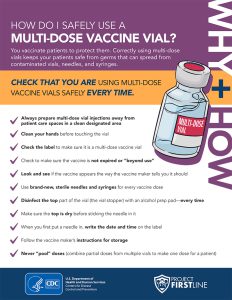Multi-Dose Vial Safety Reminders for National Immunization Awareness Month
Posted on by
August is National Immunization Awareness Month, an observance to acknowledge the importance of routine vaccination for people of all ages. Project Firstline wants to ensure that all healthcare workers who give vaccines understand the importance of safe injection practices, and that they use multi-dose vaccine vials safely and correctly.
A multi-dose vaccine vial is a vial of liquid medication that contains more than one dose of medication. Many vaccines come in small bottles with more than one dose of vaccine inside of them. These multi-dose vaccine vials are used multiple times to vaccinate multiple people with a fresh needle and fresh syringe every time. A specific set of safety procedures are required and should be used every time a vaccine is prepared and given to help ensure they don’t become dirty and possibly harm people. Here are 10 injection safety steps to remember when working with multi-dose vaccine:
- Always prepare injections away from patient care spaces in a clean designated area. Preparing multi-dose vials in a separate space helps ensure they are handled correctly and decreases the chance for mistakes.
 Clean your hands before touching the vial. Germs from your hands could get on or inside the vial and contaminate the vaccine as well as put the patient at risk for infection.
Clean your hands before touching the vial. Germs from your hands could get on or inside the vial and contaminate the vaccine as well as put the patient at risk for infection.- Check the label to make sure it is a multi-dose vaccine vial. If it’s not, the vial should only be used once for a single patient. Next, confirm the vaccine is not expired. Expired vaccines may not work as well and should not be used.
- Make sure the vaccine appears the way the vaccine maker tells you it should. If it doesn’t or you’re worried something has gotten inside the vial, don’t use it. You can check the instructions from the vaccine maker to find out what the vaccine is supposed to look like. Any unusual color or cloudiness is cause for concern because it could be contaminated.
- Use brand-new, sterile needles and syringes for every vaccine dose. Just using a new needle is not enough because if the syringe has been used, blood can get into the vial when you draw up the vaccine. Even if the syringe looks clean, you could risk the spread of viruses like hepatitis C or HIV.
- Disinfect the top part of the vial (the vial stopper) with an alcohol prep pad every time you draw up a vaccine. Germs can live on the top of the vial. If it’s not clean, germs can get pushed into the vial when you insert the needle into it, contaminating the vaccine inside. Those germs could be then injected into patients and make them sick.
- Let the vial stopper dry completely before you stick the needle in to draw up a dose of vaccine. This gives the alcohol time to kill any germs that may be on top of the vial.
- As soon as you draw up the first dose, write the date and time on the label indicating when the vial was opened. Follow your facility’s policy or the manufacturer’s label instructions to prevent the vaccine from being given to patients beyond its use date.
- Follow the vaccine maker’s instructions for storage and for how long you can use the vaccine after you first access the vial, which varies by product. Beyond-use or improperly stored vials must be thrown away.
- Never “pool” doses. Combining partial doses from multiple vials to make one dose for a patient could increase the risk of germs or other contaminants getting into the vaccine.
Injection safety is an important element of Standard Precautions and should be used in all healthcare settings with all patients or residents to prevent the spread of germs, including bloodborne pathogens like hepatitis B and C. Using multi-dose vaccine vials safely ensures that your patient gets the full benefit of the vaccine without being harmed by the injection.
For additional information on multi-dose vial safety, review Project Firstline’s videos and training toolkits, as well as CDC’s injection safety website.
Janet Glowicz, PhD, RN, Infection Preventionist with Project Firstline in CDC’s Division of Healthcare Quality Promotion
Mia Frederick (contractor, TANAQ) is a writer for CDC’s Project Firstline in the Division of Healthcare Quality Promotion.
Brittney Foster (contractor, St. John’s Group/Tanaq) is a senior health communications specialist for CDC’s Project Firstline in the Division of Healthcare Quality Promotion.
Posted on by

